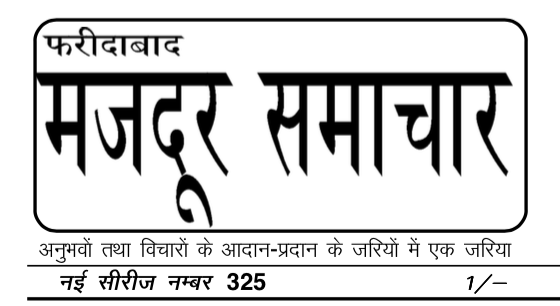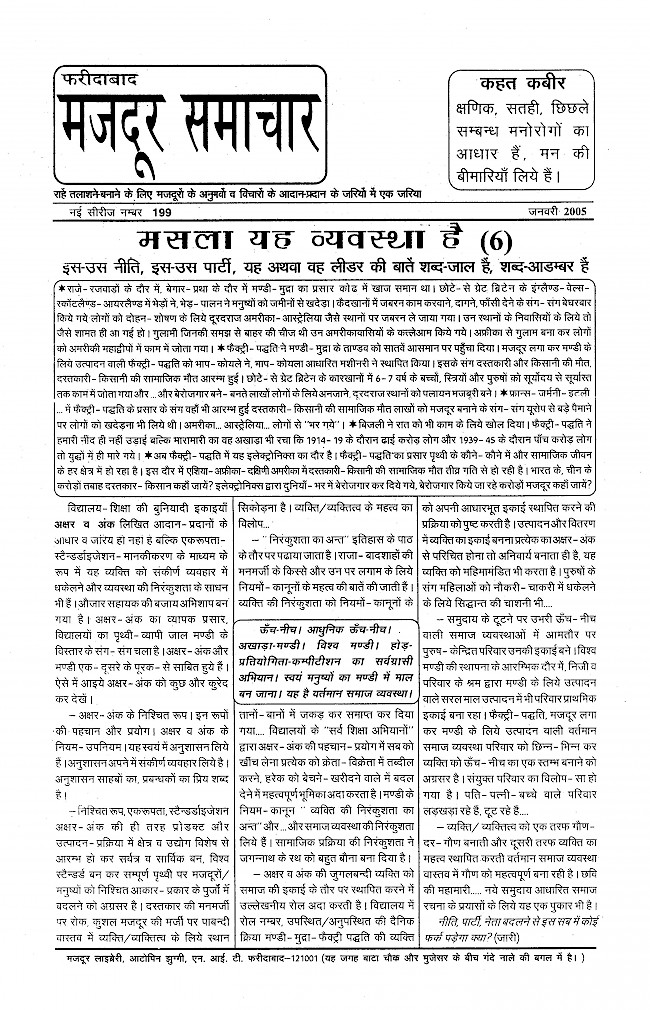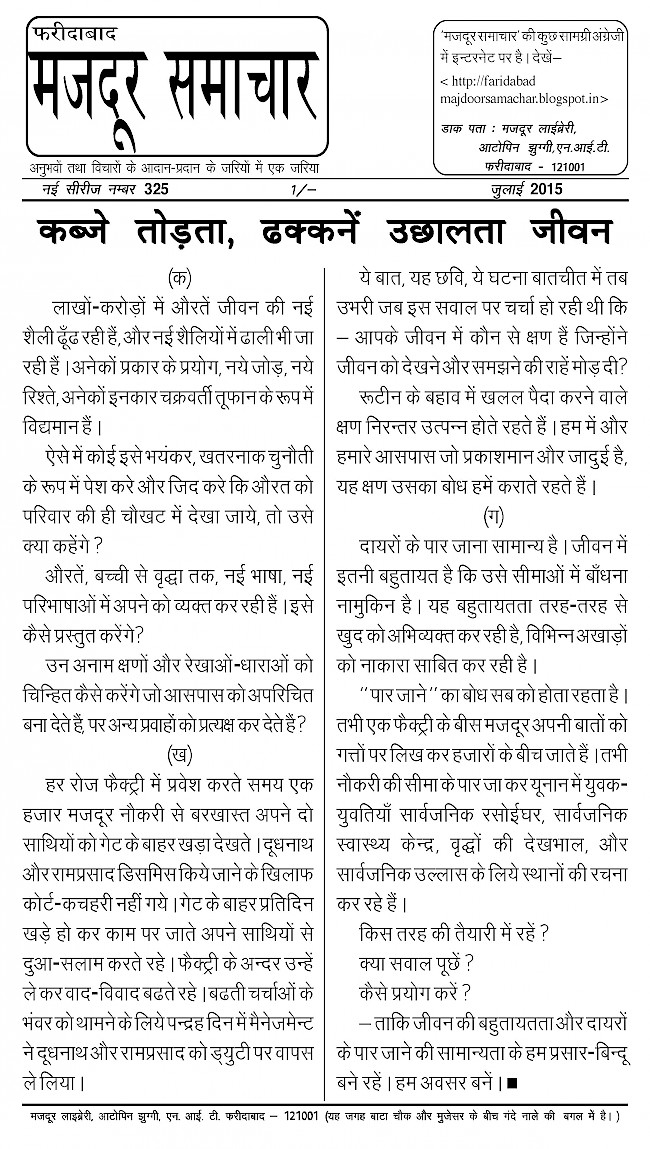— Of Work Riots, Political Prisoners, and Workers Refusing to Leave the Factory—Translated Through the Pages of Faridabad Workers News (2005–2015)

Since October 27, 2005 workers have walked the streets with placards. When we stand on paths that lead to factories at the start of the morning shift, many stop.
We exchange stories, ideas, and glances; the restlessness of management rises.1Michael Aram Exports workers, Delhi, “Workers’ Placards in Delhi,” Faridabad Workers News 209 (November 2005): 1–4. All the issues of Faridabad Workers News, and occasional translations into English, can be accessed on the newspaper’s website. See → Published since 1982, this monthly newspaper is written and distributed by a dispersed and expanding formation, in the industrial zones of more than three million factory workers. 13,000 copies are printed each month, which travel in the National Capital Region of Delhi—Okhla, Faridabad, Gurgaon, Manesar, Bahadurgarh, Gaziabad, Sonepat, and NOIDA.
The labyrinthine paper trails of the cloth mill where I, Ram Sagar, worked for thirty years and, like thousands of others, thought myself to have been a worker, have revealed themselves as belonging to seventeen different companies. This started in 1992 when, a year after having been dismissed, I filed a case with the labor court. I won in 1999, but the company didn’t comply with the court’s order. In 2001, the labor commissioner issued a summons against the chairman-managing director. It’s 2005 now, and sixteen summonses and a nonbailable arrest warrants haven’t managed to produce a soul in court. We have learned that factories belong to no one; no one owns them; names keep multiplying in documents.

Ownership is only a masquerade; owners do not exist.2“Courtroom, Alias House of Betrayals,” Faridabad Workers News 213 (October 2005): 4.
There are 2,500 of us in our factory, which produces auto parts. Hired through four contractors, we are all of a similar age. We make up 90 percent of the factory’s workforce, and get along very well with one another. In January 2007, we gathered at the gate and refused to enter the factory. Production stopped for two days. The management singled out those amongst us who they decided had incited the strike, and dismissed them. We stopped work again in August.
It isn’t a question of a few instigating many.3Delphi Automotive Systems Ltd. worker, Delhi-Jaipur Road, “From Gurgaon,” Faridabad Workers News 231 (September 2007): 4.
On Friday, December 17, 2010, workers—permanent, casual, those hired through contractors—stopped the production line in a two-wheeler production factory. The scooter line, motorcycle line, welding shop, and machine shop came to a standstill. Workers from B-shift joined A-shift workers. 1,800 permanent workers and 6,500 workers hired through contractors gathered inside the factory. While many workers left in company buses that afternoon, many stayed inside the factory through the night. Around midnight, the company declared the next day a holiday. Buses didn’t arrive the next morning with those who had left for the night, and 150 to 200 policemen entered the factory. A few months later, on April 8, 2011, workers on the night shift in a health care–product factory stopped work. When morning shift workers weren’t allowed to enter the factory, the 300 to 350 workers who were inside refused to come out. Workers outside the factory gates passed them food over the walls. On June 4, 2011, at shift change, workers on A-shift didn’t leave, and workers on B-shift entered the factory but didn’t begin work. They phoned C-shift workers. Permanent workers, trainees, apprentices, and workers hired through contractors—around three thousand workers—gathered inside the factory. Ten days passed. The company hemmed in the factory by raising miles and miles of tarpaulin sheets around it.

Workers refused to leave the factory.4Honda motorcycle and scooter worker, IMT Manesar, “Wobbly, Shaky Honda,” Faridabad Workers News 271 (January 2011): 4; Harsoria Healthcare Pvt. Ltd. worker, Gurgaon, “Harsoria Healthcare,” Faridabad Workers News 275 (May 2011): 4; Maruti Suzuki India Ltd workers, IMT Manesar, “From Honda to Maruti Suzuki: The Ways of Companies Today,” Faridabad Workers News 277 (July 2011): 4; “The Joy of Living Experience With Workers of Maruti–Suzuki,” Faridabad Workers News 279 (September 2011): 1.
A few months later, on October 7, 2011, at 4 p.m., workers from the A- and B-shifts in this same factory gathered inside the factory yet again. Workers at around ten affiliate factories that make car engines, motorcycles, and other automotive parts also stopped work and refused to leave the factories. While work resumed the next day in some of these factories, workers in four factories did not resume production and stayed inside the factories. Kitchens were set up, since companies had shut down the canteens. There was no work tension. No agonizing about the hour of entry or exit. No stress over catching a ride on a bus. No fretting about what to cook. No sweating over whether dinner had to be served at 7 or at 9 p.m. No anguishing over what day or date it was. October 7–14 was the best time. We talked a lot with each other about things that were personal. We became closer to each other during those seven days than we’d ever been.
It was as if we were seeing each other for the first time.5Maruti-Suzuki, Suzuki Powertrain, Suzuki Casting, Suzuki Motorcycle, Satyam Auto, Bajaj Motor, Endurance Technologies, Hilux, Lumax, Lumax DK, and Dighania workers, IMT Manesar, “Suzuki Manesar Diary,” Faridabad Workers News 280 (October 2011): 3–4; Maruti Suzuki India Ltd. worker, IMT Manesar, “With Calculations, Without Calculations,” Faridabad Workers News 291 (September 2012): 1, 4; “A Conversation With Students That Didn’t Happen,” Faridabad Workers News 304 (October 2013): 1, 3, 4. Trans. in “Towards a Conversation With Students: Rethinking the Figure of the Worker.” See →
Workers at a die-casting factory didn’t turn up for work on October 16, 2011, a Sunday. The next day they came to the factory, stayed inside the entire day and night, and didn’t work. On October 21, workers at a footwear company stopped work at midday. On October 24, 250 workers in the rotary, dyeing, sampling, and finishing departments of a dying and printing factory stopped work and gathered at the gate.

The riddle of “what is it that workers want” keeps deepening.6Oswal die-casting worker, Lakhani (Vardan Group) worker, and Shivalik Prints Ltd. worker, Faridabad, “Life Scripting New Time” and “Workers in Delhi–Gurgaon–Faridabad,” Faridabad Workers News 281 (November 2011): 1–2.
It was a clear day in February 2012. “Do you know,” the official from the fire department asked, holding up the fire extinguisher, “what gas is inside this?” When no one responded, the officer answered his own question, “CO2 gas. This gas can extinguish any fire, whether caused by electricity, or an accelerant like petrol or thinner. This gas can act on anything that can catch fire, be it rubber or cloth. If you hear the hooter, stop work and run towards an open space immediately.” The next day the hooter, which usually sounds at the start and end of a shift, or at lunch break, sounded at an odd hour—at 10 a.m. Everyone stopped work and rushed out of the factory. HR called security, and security assured them there was no fire. Workers stood where they were, whispering and chatting. They stopped work again at midday the next day, and again at 10 a.m. the day after that.
Everything, everywhere is flammable, and anything can be a spark.7Lakhani (Vardan Group) worker, Faridabad, “Everyone is Active—Everyone Must Act—And Let Others Know Too,” Faridabad Workers News 286 (April 2012): 4.
Over the years, thousands of workers from industrial areas in and around Delhi have been arrested and are today’s political prisoners. On July 18, 2012, after their actions in June and October of the previous year, workers in the automobile factory attacked factory buildings and managers. The government responded by stationing six hundred commandos in the industrial town. The number of political prisoners rose: 147 workers were arrested without bail and, further, arrest warrants were issued for sixty-five workers. The company fired 546 of its permanent workers and the 2,500 workers it had hired through contractors. And, as if conceding finally that the situation wasn’t one of “few and many,” in a letter that management sent each permanent worker they fired, they wrote, addressing each one by name: “We can no longer employ you because you have acted both as instigator and participant.” In the words of a worker:
“It would have been quite something if what workers did in one factory on July 18 had happened across the entire industrial town.”8Maruti Suzuki India Ltd. worker, IMT Manesar, “With Calculations, Without Calculations,” Faridabad Workers News 291 (September 2012): 1, 4; “The Actions of Workers of Maruti–Suzuki Manesar From 4 June 2011 to 18 July 2012 and Beyond,” Faridabad Workers News 296 (February 2013): 1–2; “Astonishments That Destabilize Consensus,” Faridabad Workers News 306 (December 2013): 1.
It’s July 2012 and while the management of our factory, which makes medical and surgical equipment, has been missing for a few months, there are other factories where the management may as well be missing. There’s a metal factory where workers don’t argue anymore: they just stretch the ten-minute tea breaks that the company gives them at 10:30 a.m., 3:30 p.m., and 6:30 p.m. to half an hour each. Supervisors and managers hover around, but they keep their distance. On November 9, four hundred men and four hundred women workers in a footwear factory encircled the managing director at the factory gate. Two hundred police personnel looked on, and finally retrieved him by using batons and water canons at 9 p.m.
If there ever was a consensus, it has been broken. This isn’t the time to make petitions; it’s the time to make proposals.9Eastern Medikit Company worker, Gurgaon, “It’s Important to Search for New Ways,” Faridabad Workers News 289 (July 2012): 3; Saket Fabs worker, Faridabad, “A Look Inside Factories,” Faridabad Workers News 290 (August 2012): 2; Lakhani (Vardan Group) worker, Faridabad, “Inside Factories and Workplaces,” Faridabad Workers News 294 (December 2012): 3.
On February 21, 2013 at 10 a.m., in an industrial area thick with garment-manufacturing units and printing presses, a handful of workers stepped out from their factory and started shouting slogans. This drew out around fifty workers from surrounding factories. Within moments, another 1,200 joined them. By 10:30 a.m., the frightened managers of twenty-four factories declared the end of the workday. Within the next half-hour, as more and more factories across the industrial area shut down one after the other, workers gathered outside factory gates. Across the entire industrial area, thousands pelted stones at factory buildings and broke car windshields and placed boulders on their seats. In the words of a worker:
“Who’s to say what spurred the women on more than it did the men, or where the laughter on every face that day came from.”10Okhla Industrial Area worker, Delhi, “20–21 February in Okhla Industrial Area: 4,000 Factories, 5,000,000 Workers,” Faridabad Workers News 297 (March 2013): 1, 3.
On April 16, 2013 at 10 a.m., tailors working on the second floor of a garment factory stopped work, came down, turned the guards out and locked the main door of the factory from inside. Then they switched the power supply off, shutting down work on all four floors. In August, when banks sealed one of the production units of a footwear company, the chairman and the director of the company asked the hundred workers they had shifted out of that production unit to help them break the lock and resume work there. The workers refused. Starting on August 30, guards employed by a security company started a sit-in at the company headquarters, as well as outside their work sites—the Australian embassy, the offices of UNDP, UNICEF, and the World Bank. At 8 a.m. on September 22, workers in a factory that produces plastic injection molding components gathered outside the factory. Workers from two other automotive-parts factories supported them. They resumed work at 1 p.m. Four days later they stopped work again and gathered outside the factory. On the morning of January 23, 2014, groups of workers went from one factory to another. Workers poured out of factories. They even went into the directors’ office and asked them to come out. Factory after factory closed. Workers went back into the factories when police arrived. When the police left, they came out again.
A simple laugh at the correct moment can produce a crack in the strongest of edifices.11SMS Export worker, Delhi, “A Look Inside Factories,” Faridabad Workers News 299 (May 2013): 2; Lakhani (Vardan Group) worker and Shivalik Prints Ltd. worker, Faridabad, “A Look Inside Factories,” Faridabad Workers News 303 (September 2013): 3; G4 Security Solutions worker, Delhi, “G4 Security Workers,” Faridabad Workers News 305 (November 2013): 4; Auto decor worker, IMT Manesar, “A Glimpse of Cracks and Leakages Inside Factories,” Faridabad Workers News 305 (November 2013): 2; Baghaula-Prithla Industrial Region workers, Palwal, Haryana, “Groups of Workers Went From Factory to Factory,” Faridabad Workers News 308 (February 2014): 4.
In 2014, friends came with lots of stories. Around the end of January, a charge sheet from an auto factory in Pune, Maharashtra circulated. In it, the management had charged its workers: “You were laughing, singing, dancing on the production line, changing your position on the line at your own will, stopping the production line on purpose, and you refused to listen to supervisors. This is a violation of the terms of agreement between the company and the union.” In March, another trend was being praised: workers in garment factories across Bangladesh stopped work suddenly and routinely. Production stopped for many days. There were no leaders; there was no one to negotiate and come to an agreement with. In May, we gathered over tea to listen to a friend who had returned after three years from a construction site in Saudi Arabia. “There are constant tussles at the construction site,” he said. Skirmishes are routine—between workers and foremen, as well as between workers and engineers and managers. Workers, whether we are from Bhagalpur or Gorakhpur, Delhi or Karachi, Lahore or Ludhiana, Dhaka or Pokhra, live together, and we talk to each other all the time in the dormitories—about the lateness of wages, minutes snatched away from a break, the arrogance of an engineer, the shortcomings of the director, an argument following an increase in work speed, an accident, a warning letter issued to a coworker, nonpayment of overtime, or the cooling in the dorm. The tipping point is uncertain, unknown, but always near. Things can spiral out of control any moment. One day, we suddenly decided we wouldn’t leave the dorm and go to work. The vehicles that came to pick us up went back empty. Managers arrived a few hours later and asked us to return to work. No one agreed; no one went. One day turned into ten. On the eleventh day, police arrived and fired shots in the air. No one left the dorm. The same thing happened the next day, and the next. Such refusals happen around six to eight times a year. Sometimes for a few days, and sometimes for an entire month, workers refuse to leave the dormitories.
With every story, trends multiply. Factory rebels on the move are joined by those who do not leave the factory, and then by shop-floor revelers, and soon by those who do not leave their dormitories to go to work.12“Laughing, Dancing, Singing on the Assembly Line,” Faridabad Workers News 308 (February 2014): 4; “No One’s Coming to the Table,” Faridabad Workers News 309 (March 2014): 3; Construction worker for Arabtech Construction, “Saudia Arabia: The Third Wave,” Faridabad Workers News 312 (June 2014): 1, 4.
On November 4, 2014, all of us workers in an electronics factory who had been hired through contractors gathered outside the factory at 6 a.m. Police, security guards, contractors, and managers blocked our path to the factory. We set up a tent 150 meters away from the factory gate, and we were shown a court order forbidding us from going any closer. Upon being approached by leaders of political groups with different dispositions, we gave them the stage, but with this caveat: “We’ll listen to everyone, but we’ll do what we want.” One leader stood at the microphone and invited us to join his political group. “It’s nice of you to have come,” we said, “but we have seen, and understood well, what you did in another factory. Goodbye.” Another leader spoke at great length about the need to change the government. “We respect your age,” we said, “but not this talk about deferring change to the future.” When groups objected to a speaker who came on stage next, we countered, “This stage is ours. We will decide who can, or won’t, speak.” As the protest stretched on and continued into March 2015, many among us joined different factories. We have active linkages between us. And we have decided, wherever we work, we’ll keep discussions open between us and won’t let any middlemen come into the relations we engender.
Whether alone, or in a cluster, or as a crowd, we become nodes that both relay and occasion the new in entire industrial zones.13Asti Electronics workers, IMT Manesar, “A Conversation With Temporary Workers,” Faridabad Workers News 322 (April 2015): 1, 3, 4.
×


